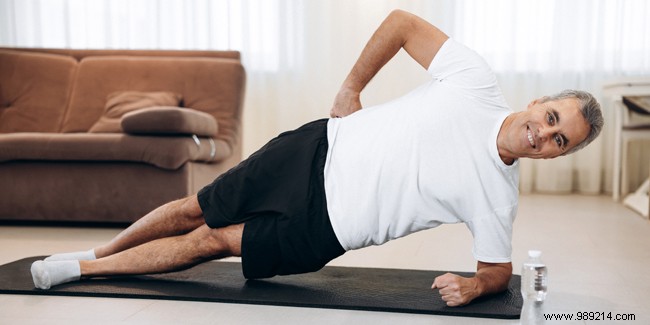
From the age of 60, it is essential not to sink into the excesses of a sedentary lifestyle and to continue to fully mobilize the body. Fatigue and shortness of breath can occur more quickly than at a younger age, but you should not stop at this detail and continue to maintain your physical shape, otherwise overweight, diabetes, high blood pressure or even dyslipidemia threaten. Gymnastics is an excellent physical activity to protect against these health problems. Here are the 4 essential exercises.
The practice of gymnastics from the age of 60 has a few simple goals, which must be kept in mind when practicing, to adapt it to your physical condition:
All this helps to maintain autonomy for as long as possible.
You should start physical activity as soon as possible to prevent joint pain from setting in. The heart is the first muscle to benefit from the practice of gymnastics. The movements performed help to maintain its power of contraction to ensure optimal oxygenation of the body.
The practice of gymnastics is not complicated in itself and the exercises can be done at home if you do not like group practice.
By devoting a minimum of 10 minutes each day to performing calisthenics exercises, you are guaranteed to stay in shape.
If you practice alone, it is advisable to perform the exercises in front of a mirror to check that the body is positioned correctly. Indeed, as simple as an exercise can be, if it is poorly done, it can in the long run cause damage (friction of the joints and therefore premature wear, for example). Also, it is important to respect the different instructions related to each exercise.
You must also take care of the quality of your breath . It is best to inhale and exhale through your nose. However, if it is more natural for you to exhale through your mouth, you can very well place the breath this way. The important thing is to always inhale at least through your nose.
Finally, accept your body as it is. This does not mean that you should succumb to laziness on the days when you do not feel like doing your exercises, otherwise you will quickly find a whole bunch of excuses and end up not doing anything. Maintain your motivation, if necessary by regularly reviewing the benefits you can derive from it. On the other hand, this does not mean that the body is subject to forced labour. If activities carried out the day before (gardening, DIY, playing with the grandchildren, etc.) have caused pain or aches, try to preserve these areas and favor exercises that do not require them too much. Pain can prevent you from performing an exercise correctly. It is therefore better to wait for it to fade rather than to insist and hurt yourself.
The ideal is to dedicate the time for gymnastics away from meals, at the end of the morning, or in the middle or at the end of the afternoon. Digestion can indeed disrupt the performance of exercises and vice versa.
Warming up is also essential. If you insist on doing your exercises early in the morning, increase the warm-up time.
Finally, don't neglect your recovery time, which is usually longer than the time spent exercising.
The exercise consists of:
Repeat this exercise 5 to 10 times, taking the time to perform the movements and without sinking into the chair. If you find it difficult to keep your back straight, push your buttocks back and lean back (provided the seat back is not tilted backwards).
If you feel pain, decrease the amplitude and/or the number of movements. If there is no pathology identified in your shoulders, it is important to insist on doing part of the movement. As you exercise, your range of motion should increase.
Sit on the edge of your chair.
Raise the right knee and cross your hands in front of the knee.
Repeat the exercise with the other knee and alternate the movement from one side to the other 5 to 10 times, always taking the time to perform the movements and to breathe deeply.
On a floor mat, get on all fours. If the wrists are painful, do not rest on the palms of the hands but on the closed fists, to keep the wrist in the extension of the arm, without “breaking” it. If the knees are sore, place a folded plaid once or twice. It should only be thin. If only one knee hurts a little, still place the thickness under both knees so that your position is balanced.
You repeat the exercise 5 to 10 times, slowly, in coordination with the breath.
You stand next to a wall for support. This support must remain light and only serves to help you maintain your balance.
You start by leaning with the left hand or forearm on the wall. You spread the right leg to the side, without leaning the body towards the wall, and draw in the air 10 small circles in one direction and 10 small circles in the other. If necessary, put the leg on the ground before changing direction.
You do the same thing by leaning with the right hand or forearm on the wall. It is the left leg that is mobilised.
Throughout the exercise, be sure to keep both legs straight, your body straight and to breathe slowly and deeply.